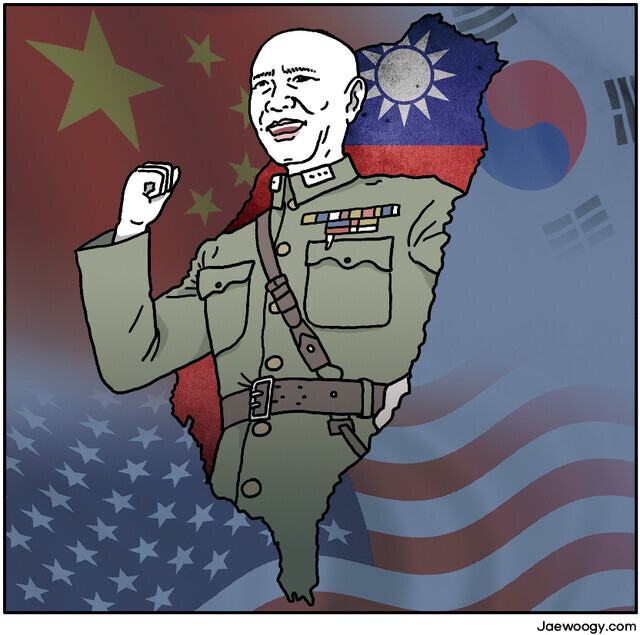hankyoreh
Links to other country sites 다른 나라 사이트 링크
[Column] The history linking Taiwan and the Korean Peninsula

On Aug. 4, Chinese Ambassador to the US Qin Gang published an opinion piece in the Washington Post protesting US Speaker of the House Nancy Pelosi’s recent visit to Taiwan.
“Taiwan has been an inseparable part of China’s territory for 1,800 years,” he wrote. But historians might raise some issues with that assertion.
Since the Stone Age, Taiwan had been home to an indigenous population that was not Han Chinese. Many Han people were relocated there to serve as workers while the island was being occupied and governed by European empires such as the Netherlands and Spain in the 17th century. The name “Taiwan” is reported to have come from “Tayouan,” a southern Taiwan commercial post of the Dutch East India Company, which it named after a local indigenous tribe.
A mainland Chinese dynasty first came to rule over Taiwan in 1683, when the Qing put down the forces of Koxinga (Zheng Chenggong), who was using the island as a base for a Ming revival movement.
The fates of the Korean Peninsula and Taiwan have been closely intertwined since the late 19th century. After suffering defeat in the First Sino-Japanese War, which involved a battle with Japan for sovereignty over the Korean Peninsula, Qing China ceded Taiwan to Japan with the Treaty of Shimonoseki in 1895.
The Korean Peninsula and Taiwan each became Japanese colonies 15 years apart. In 1949, a year after the Korean Peninsula was divided into South and South, the Kuomintang under Chiang Kai-shek lost control of mainland China to the Communist Party and established a new government in Taiwan.
At the same, the US had no thought of recognizing Taiwan as its own country. Many in the US government distrusted Chiang, even exploring the possibility of collaborating with the Chinese Communist Party. Washington declared that it would not intervene in matters related to defending Taiwan, while the CIA predicted Chiang’s regime would not last through the end of 1950.
All that changed when the Korean War broke out on June 25, 1950. Two days later, the US sent its 7th Fleet into the Taiwan Strait — a move sparked by concerns that the People’s Republic might take advantage of the situation to occupy Taiwan, allowing communism to spread.
The move also had the aim of heading off a scenario where the Chiang regime might attack the mainland, causing the clash to spread. Taiwan’s survival amounted to a twist of fate.
After the Korean War was suspended with the Armistice Agreement on July 27, 1953, China began shelling the Taiwanese island of Kinmen on Sept. 3, 1954, in order to prevent the US from signing a security treaty with Taiwan. This incident became known as the First Taiwan Strait Crisis.
But China’s provocations only fueled the negotiations between the US and Taiwan. On Dec. 2, 1954, the two sides signed the Sino-American Mutual Defense Treaty.
In Cold War-era South Korea, the Republic of China was commonly referred to as “Free China.” But the reality was a regime of anti-communist dictatorship under a system of martial law.
Both South Korea and Taiwan became democracies more or less around the same time in the late 1980s. But before their people could engage in any real mutual communication and interchange, South Korea severed ties with Taiwan and established diplomatic relations with China on Aug. 24, 1992.
A US Forces Korea U-2 reconnaissance aircraft was reportedly sent to the Taiwan Strait on Friday, while China was staging large-scale military exercises all around the body of water. The crisis in Taiwan is bound to the Korean Peninsula.
The strategic values of the Korean Peninsula and Taiwan may rise every time the continental and maritime powers are battling for dominance, but that also leaves both of us in a more precarious position. In that sense, we’re partners in misery.
By Park Min-hee, editorial writer
Please direct questions or comments to [english@hani.co.kr]

Editorial・opinion
![[Editorial] Exploiting foreign domestic workers won’t solve Korea’s birth rate problem [Editorial] Exploiting foreign domestic workers won’t solve Korea’s birth rate problem](https://flexible.img.hani.co.kr/flexible/normal/500/300/imgdb/original/2024/0626/5517193887628759.jpg) [Editorial] Exploiting foreign domestic workers won’t solve Korea’s birth rate problem
[Editorial] Exploiting foreign domestic workers won’t solve Korea’s birth rate problem![[Column] Kim and Putin’s new world order [Column] Kim and Putin’s new world order](https://flexible.img.hani.co.kr/flexible/normal/500/300/imgdb/original/2024/0625/9617193034806503.jpg) [Column] Kim and Putin’s new world order
[Column] Kim and Putin’s new world order- [Editorial] Workplace hazards can be prevented — why weren’t they this time?
- [Editorial] Seoul failed to use diplomacy with Moscow — now it’s resorting to threats
- [Column] Balloons, drones, wiretapping… Yongsan’s got it all!
- [Editorial] It’s time for us all to rethink our approach to North Korea
- [Column] Why empty gestures matter more than ever
- [Editorial] Seoul’s part in N. Korea, Russia upgrading ties to a ‘strategic partnership’
- [Column] The tragedy of Korea’s perpetually self-sabotaging diplomacy with Japan
- [Column] Moon Jae-in’s defense doublethink
Most viewed articles
- 1Blaze at lithium battery plant in Korea leaves over 20 dead
- 2CIA record confirms US ‘completely destroyed’ Seoul’s Haebangchon in 1950 bombardment
- 3How sanctions are backfiring to fuel a new Eurasian alliance
- 4How 17 km of river could be a fertile bed for NK-China-Russia cooperation
- 5[Column] Kim and Putin’s new world order
- 6Dispatched into unknown danger, foreign day laborers were defenseless against blaze
- 7[Editorial] Workplace hazards can be prevented — why weren’t they this time?
- 8What made Korea’s lithium battery plant fire so deadly
- 9Foreign day laborers make up majority of death toll in Korean battery factory fire
- 10[Editorial] Exploiting foreign domestic workers won’t solve Korea’s birth rate problem